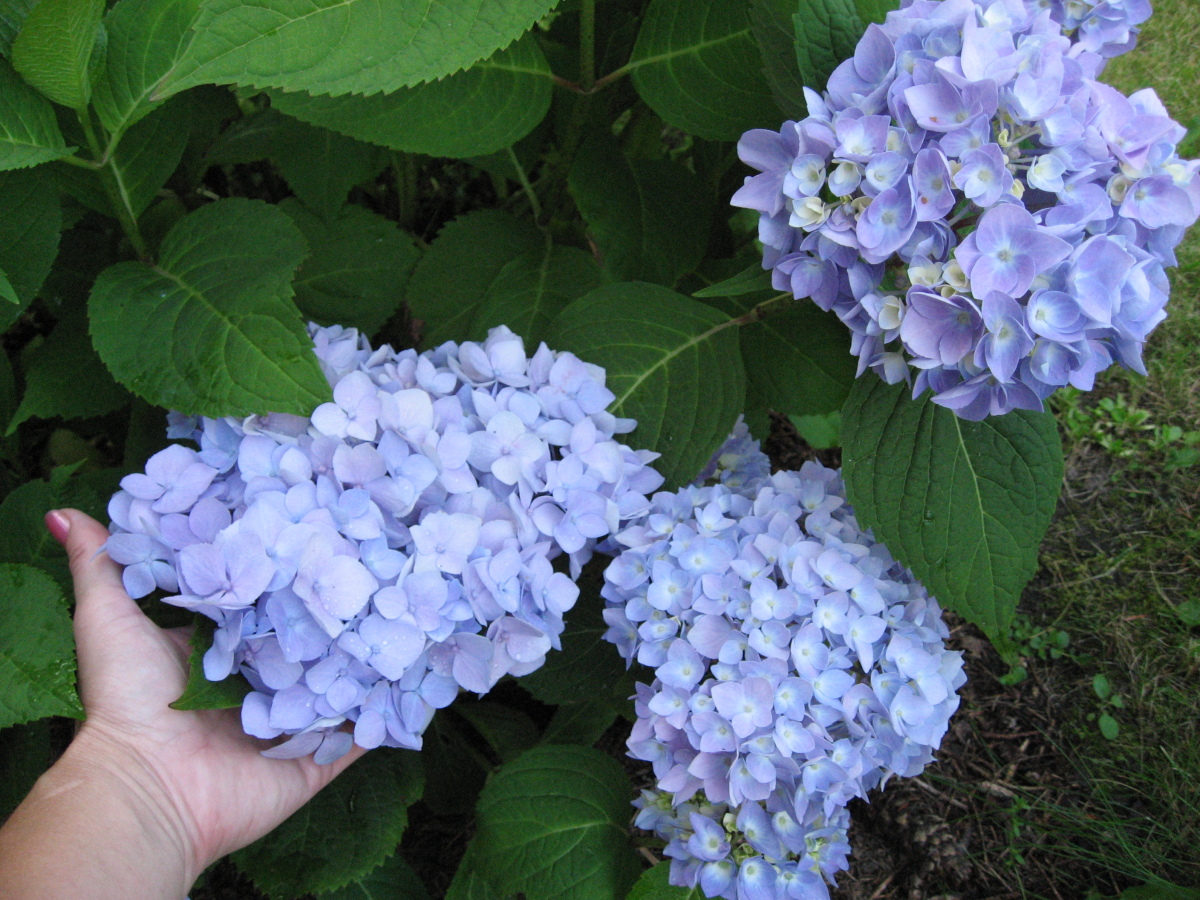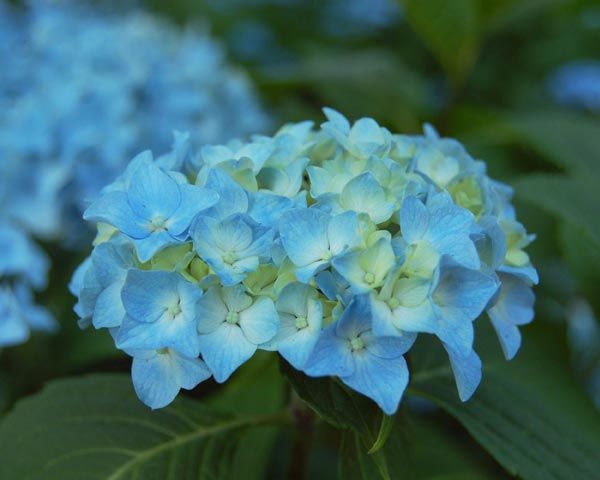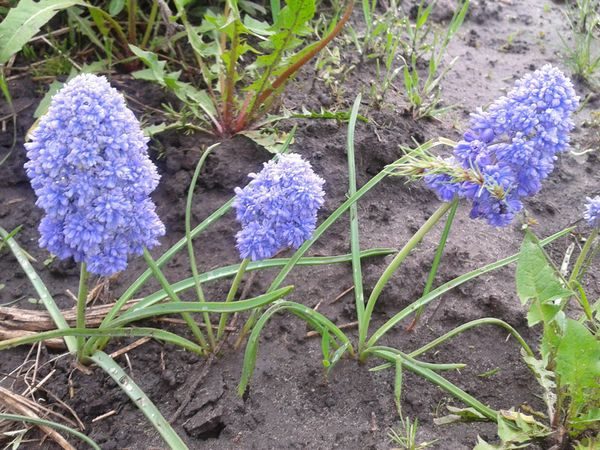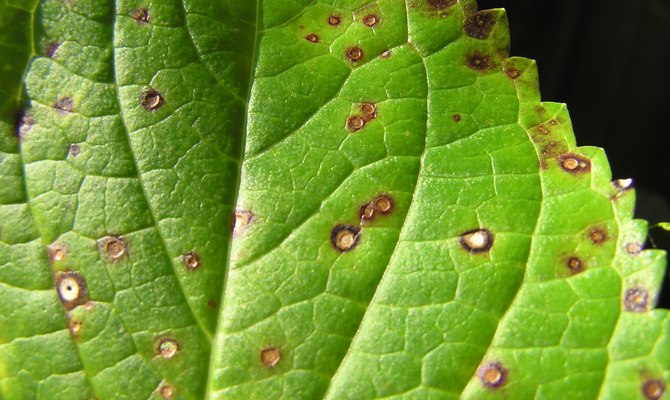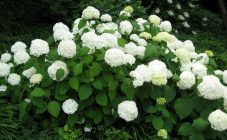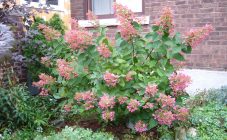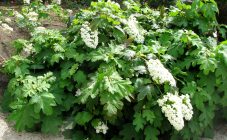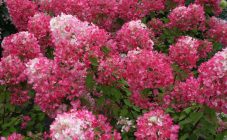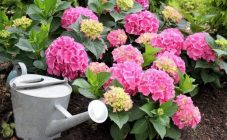Content:
Flowers make not only the garden beautiful, exquisite, when watching them, the mood rises and delights the eye. Probably, every gardener, growing various plants, wants to bring something unique, unusual. Such plants include hydrangea, which will decorate any garden and satisfy connoisseurs of rare crops.
Features and characteristics
Hydrangea translated from Latin means "water", "vessel". This is a plant of the genus Flowering family Hortensiae. It reaches a height of 1 to 3 m, depending on the variety. It has lush inflorescences, collected from small flowers in a ball resembling a pompom. The plant is frost-resistant, loves moisture, does not tolerate strong sunshine and wind.
Hydrangea was brought to Russia from South and East Asia, North and South America. It was named so because of the shape of the seed pods and dependence on moisture. There are several groups of hydrangea species. Popular:
- tree-like;
- paniculate;
- large-leaved.
Flowers have different colors: red, lilac, white, beige, blue, blue. It depends on the pH value in the soil. With low acidity, the inflorescences are white and beige. In alkaline soil, the flowers acquire a pink tone, in acidic soil, a blue hydrangea is obtained. Many gardeners who know how to regulate the pH in the soil can achieve the desired flower shade.
Treelike, paniculate hydrangea blue does not exist, but in another color they look spectacular, moreover, they are more frost-resistant and unpretentious to care for. In contrast, large-leaved inflorescences of rich shades of blue can be achieved.
Hydrangea blue: description and varieties
A large-leaved hydrangea bush tends to accumulate aluminum in the trunk of acidic soil, which gives a blue color to flowering. Many varieties of blue hydrangea have been bred:
Hydrangea Mini Penny
It reaches a height of 60-90 cm. It is distinguished by large, spherical flowers of a blue hue. In alkaline soil, they turn pink. The leaves are bright green. This name was given to the Mini Penny hydrangea due to the compact size of the bush. The flowering period is from July to September. Cover for the winter. If this is not done, then the plant may freeze, but it will quickly recover, although it will not bloom so abundantly.
Freedom
This plant does not turn blue immediately. From the beginning of flowering, the hydrangea is white-pink, gradually the color changes to blue. On one bush there can be flowers of different shades at the same time, therefore many call it as a pink-blue hydrangea. Inflorescences reach 15 cm in diameter. The leaves are dark green with denticles along the edge. Loves shady terrain, abundant watering.
Ramars
The bushes of this variety are distinguished by multi-colored buds. They are completely covered with purple, purple flowers, or bloom blue-white or blue inflorescences. The bush reaches 80 cm in height, moisture and shade-loving.
Hopcorn Blue
Many call it that - Popcorn hydrangea. The color is bright lilac or purple. Prefers a lighted area, no need to cover for the winter. The bush reaches 1 m in height. Blooms from July to September.
Jomari
The flowers are large, star-like, blue or blue. The bush reaches 80 cm in height. It blooms from June to October.
Compeito
Hydrangea of this variety has a lilac-blue tint of inflorescences, the middle of which is white. The plant has smooth petals, oval leaves with ribbed edges.
Blueberry Cheesecake
Bush height 80-120 cm. Characteristic features: branched shoot, flat petals, inflorescences up to 20 cm in diameter. The variety does not like direct sunlight. At the end of flowering, the leaves turn reddish.
Spike Blue
Inflorescences are large, spherical. The flowers are blue or pink, petals with wavy edges. They bloom on the shoots of last year and this year from July to September. Reaches 120 cm in height.
Hydrangea Blue Wave
The variety was developed in Holland. It differs from other bushes by a strong stem. The peak flowering occurs in mid-July and throughout August.
Planting and caring for blue hydrangea
First, you need to choose a place where there will be no bright sun in the middle of the day, since this plant loves more shade or partial shade. On an area where the wind is constantly strong, the plant will not grow and will not please with lush and long flowering.
Soil preparation requires special attention. You need to fertilize it with a special mixture for hydrangeas or do it yourself. For the last option you will need:
- land from the forest;
- peat;
- sand;
- humus.
To independently analyze the soil using litmus paper, you need:
- On the plot of land selected for planting hydrangeas, pour settled water into the soil, bring to a liquid slurry.
- Dip a strip of litmus paper there for 5-10 seconds.
- Compare the obtained color with the scale on the table attached to the package.
Hydrangea can be propagated vegetatively (by cuttings, dividing a bush, layering), and also planted with seeds. There should be at least 1-2 m between the bushes, then the flowers will be large.
Before planting, you need to dig a hole about 60 cm deep. Prepared soil should be poured into it, the seedling should be stuck into the hole, and the roots should be sprinkled with earth. Then pour 20-25 liters of water abundantly under each bush. Then sprinkle with a small layer of mulch (peat, tree bark) to retain moisture.
During the period of active bud formation, it is recommended to additionally fertilize the bushes with superphosphate (60-70 g) and sulfuric potassium (40-45 g) per 1 m².
Watering hydrangea in dry weather is necessary 2-3 times a week, 2-3 buckets under each bush. The water should be warm.
Hydrangeas need to be fertilized throughout the flowering season. It is advisable to do this in three stages:
May:
- superphosphate;
- urea;
- potassium sulfate.
Mix everything in a 2: 1: 5: 2 ratio.
During the period of active budding:
- superphosphate;
- potassium sulfate.
The third feeding is at the end of summer. Any organic fertilizer is suitable as fertilizer.
Shrubs are pruned in spring. This is done only on adult 4-5 year old bushes, removing old shoots and overgrown young ones. Also, the tops are pruned, the dried flowers under the cap itself are not lower than the first bud. This improves the hydrangea's immune system, encourages the growth of new shoots and ensures the splendor of the shrub.
Preparing for winter
The winter hardiness of this plant surprises many flower growers. Yes, hydrangea successfully tolerates winter, but it definitely needs to be prepared for frost.
At the first frost, the base of the trunk is spud. Later, it is advisable to cover with agrofibre, then cover with a wooden box and cover with agrofibre on top. This will preserve the root system, and in the spring the plants will wake up safely and grow.
Diseases
If you take care of the hydrangea incorrectly, this can provoke the appearance of diseases from which the buds and leaves suffer, which ultimately, if no measures are taken, leads to the death of the entire bush.
Gray rot
Young shoots are covered with brown spots. If the problem is not eliminated in time, the flowers may suffer, and then the whole plant will be covered with a gray bloom.
Treatment:
- remove damaged flowers;
- disinfect;
- process the bush with foundation or rovral;
- ensure proper watering and ventilation.
Powdery mildew Erysiphecommunis mushrooms
This disease is provoked by the fungi Erysiphecommunis. It affects the entire plant, preventing it from developing. Over time, the hydrangea withers and dies. As a treatment, you need to remove the affected branches and flowers and treat the bushes with fungicides.
Landscape
Hydrangea looks beautiful both in compositions and singly. They decorate the entrance near the house, lawns with it. It is also popular in decorating city squares and parks. Used as a hedge to divide the garden into zones. The original bouquet is obtained with decorative grass.
Growing blue hydrangeas is not an easy process. However, by strictly observing all planting and grooming requirements, amazing results can be achieved.
